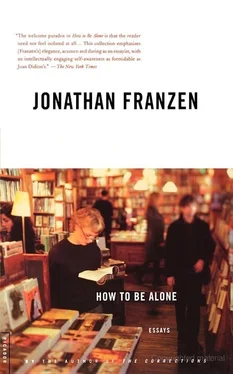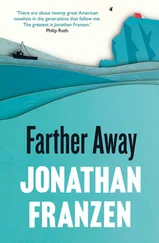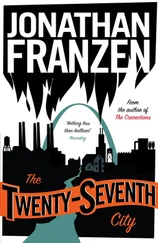However much big cities vex the Postal Service, they still generate the high volume of mail that pays for universal service. If they are structurally doomed to slower service, as Henderson suggests, then something has to suffer — either the cities or the Postal Service. And it’s clear that the cities are suffering already. By subtracting from the quality of life and adding to the cost of doing business, poor mail service helps drive corporations and affluent individuals to the suburbs. It’s a process that dismays committed city dwellers, like Marilyn Katz. “To me,” Katz says, “cities are the lifeblood of culture, the lifeblood of democracy, because they’re one of the few places where you have a real integration of different kinds of people. One of the things that’s happened, as society has become more stratified, is that in almost every realm of public service cities have become second-class citizens. The Postal Service works in Wilmette. It doesn’t work in Chicago.”
The Postal Service, for its part, is not harmed by the flight to Wilmette. What does pose a threat is virtual flight, the flight to alternative information-delivery systems. Business-to-business correspondence, which the Postal Service estimates has diminished by a third in the last five years, is where the impact of faxes and e-mail is most visible. So far, this loss has been offset by a robust flow of first-and third-class advertising mail. And boosters of the Postal Service, like William Henderson, sound confident that its usefulness will survive the development of the national information superstructure that Vice-President Gore so warmly heralds. “Mail is the most interactive product in the United States today,” Henderson says. “You can put a letter in your pocket, read it anywhere. It’s the ultimate in interactivity.”
The problem is that the Postal Service need not lose much business to run into serious trouble. In his first appearance before Congress, in 1992, Marvin Runyon described how rising postal rates had already driven third-class advertisers to alternative forms of delivery, like television, or flyers hung from doorknobs. “As we increase our rates,” Runyon said, “the Postal Service will be privatized by outside sources. Not by us but by outside sources.”
Because of its commitment to universal service, the Postal Service has large fixed infrastructure costs. It can’t shrink and grow like most ordinary companies. For this reason, the Internet won’t have to render it obsolete in order to throw it into crisis. The information superhighway need merely exist as an increasingly attractive alternative. If enough mailers, private and corporate, begin to use it, an economic thunderstorm of upward-spiraling rates and downward-spiraling service and mail volume will ensue. When this happens, Congress will have two choices: either subsidize or privatize. Returning to federal subsidy of postal rates would require an honest admission that universal flat-rate service is an expensive ideal; it would cost taxpayers money. The possibility exists, therefore, that the Postal Service will be privatized, with lucrative markets like Wilmette and the Chicago Loop being sold off to the highest bidder, and the post office remaining as an underfunded rump, a carrier of last resort, serving the rural and urban poor.
AT 2:30 ON A HUMID summer afternoon, I drive west from the Loop on a superhighway. While staying in the city I haven’t spent more than twenty-five minutes traveling to an appointment, on the El or on foot. On the national transportation infrastructure, by maneuvering aggressively, I reach the city limits in just under an hour. Traffic in the suburbs is no better. Cars stretch bumper to bumper into the western distance on roads that are being widened, or widened further, even as we drive on them. Only at my destination, a new mail-processing plant in Carol Stream, have the industrial parks and condos paused in their advance across the cornfields.
The Postal Service’s hopes of survival are pinned on growth. To avoid an upward rate spiral, losses in the volume of personal communication must be offset by gains in business-to-household mailings. Already, in the United States one in five advertising dollars is spent on direct mailing, and William Henderson believes that the figure will increase as companies realize the potential of sending out advertisements in envelopes that contain bills or that masquerade as bills. He’s particularly excited about the recent proliferation of credit cards.
To keep pace with rising volumes, the Postal Service of the future will also have to be further automated, and at Carol Stream full automation is close to being a reality. The plant is a technological showcase, with conveyor belts and hoppers and pathways all painted in gum-ball colors, and a control room on whose friendly CRT screens you need only touch an interesting or troubled node with your finger and it interacts with you. There are machines that shuffle and reshuffle envelopes into the order in which a carrier delivers them. There’s a machine that sprays a phosphorescent bar code on the back of each hand-addressed letter and transmits a video image of the address to Knoxville, Tennessee, where workers read and key in the zip code, which is then beamed back to Carol Stream and applied to the front of the envelope in the form of a black bar code. There’s a din from facer-cancelers, from optical character readers, from letter-sorting machines, from passing motorized mule trains, from hook belts and flat-sorters and delivery bar-code sorters; but it’s a level din, a supportive din. The only product of this plant is order. The fluid to which order is brought is predominantly white. It conforms agreeably to friction belts and robotic claspers. It floats, it whispers. It’s called the mail stream, and, unlike the mail at Chicago’s Central Post Office, it has no discernible personality. I’m absurdly pleased when I discover, in a small-parcel sack labeled “Nixie,” a solitary padded mailer, somewhat torn, that is addressed to a pouch number in Prudhoe Bay, Alaska, and bears a return address of Uncertain, Texas.
Leaving Carol Stream, I drive past soybean fields and a plant that bottles Zima. At the end of a strip mall thirty-seven hundred feet long and one store thick, I happen on K’s Mail Center, a bright, clean outfit that offers not only mailboxes and United States stamps but also a notary service, plain-paper faxing, desktop publishing, key duplication, wrapping paper, and humorous greeting cards. The proprietor, a personable Nigerian immigrant named Chris Kator, keeps long business hours and provides every imaginable shipping service. Kator tells me he acquired his franchise because of the synergy among the services he offers, the opportunities for growth. He says he has no complaints with the Postal Service, although few of his customers choose it for sending packages.
In the air-conditioned cool of Kator’s store, amid unhumming beige equipment in its Powr-Savr mode, the march toward privatization — toward a fragmented republic of terrific bargains and unconscionable gougings — seems to me irresistible. So does the idea that the place to which Americans should go to participate directly in the system that governs them is not a small-town post office with Old Glory in its lobby but an exurban retail outlet with Day-Glo banners (WE SELL BEEPERS) in its plate-glass window.
Back in the city, however, after another unpleasant superhighway experience, I succumb to nostalgia. I think of the delight with which Mary Ann Smith describes the Christmas card, “with a gold-foil envelope and a gold-stamped return address,” that a former alderman sent her from prison. I think of my own delight when I discover that before Debra Hawkins became a communications specialist she was a clerk in the Central Post Office who sorted mail for the neighborhood of Pilsen, and so may have personally handled the letters I sent to my brother in his apartment there. I think of the Evanston carrier, Erich Walch, who says that the customers on his new route all hated their ex-mailman and therefore hated him. “It took over a year for some of these people to look at me as a human being, to not grunt when I said good morning to them, but I’ve changed their perceptions,” he says. I think of the old Polish-American women who stand on their porches and break into smiles as they take envelopes from the hand of the African-American carrier who is also, in his other life, a minister. I think of the mail piling up for me at home in Philadelphia, and I feel a keen anticipation.
Читать дальше
Конец ознакомительного отрывка
Купить книгу












